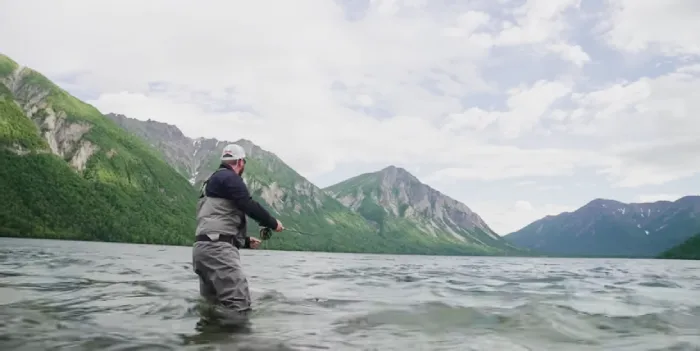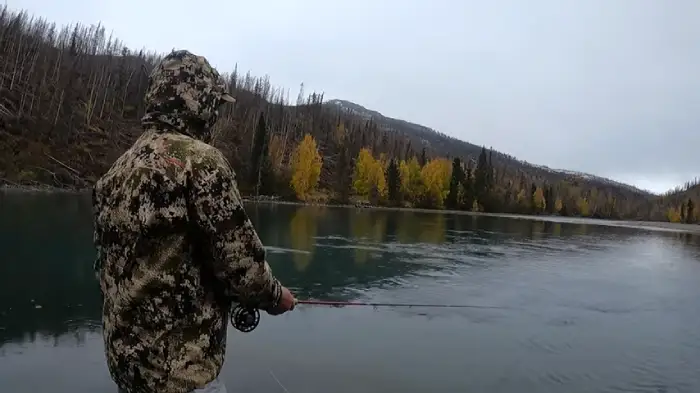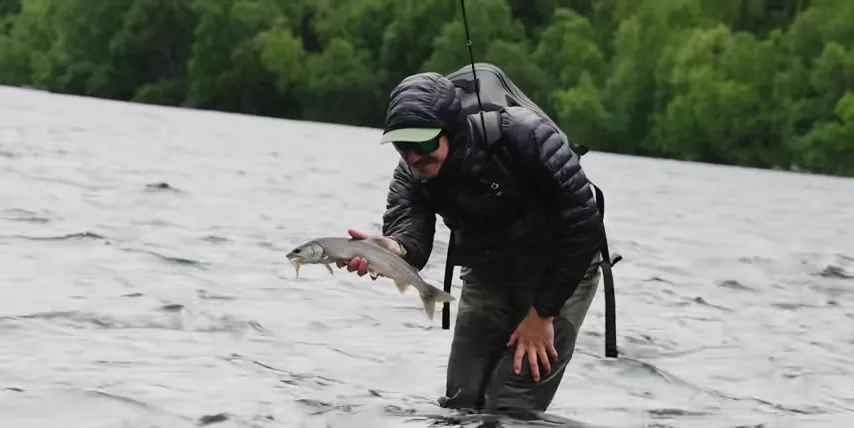Key Takeaways:
- Alaska offers a wealth of top fly fishing spots, including rivers like Kenai, Kasilof, and Russian Rivers, known for King Salmon, Sockeye Salmon, and Rainbow Trout.
- Remote locations like Prince of Wales Island, Baranof Island, and Denali Highway provide exclusive and tranquil fishing experiences with diverse fish species.
- Different times of the year offer opportunities to catch specific fish species, such as spring for trophy King Salmon and fall for Rainbow Trout and Silver Salmon.
- Fly fishing regulations in Alaska are essential to maintain sustainable practices, with specific rules for each fish species and penalties for non-compliance.
- Fly fishing enthusiasts can target a wide range of fish, including King Salmon, Rainbow Trout, Arctic Grayling, Northern Pike, and various Pacific Salmon species. This ensures a diverse and exciting fishing experience in Alaska’s pristine waters.
Alaska’s Top Fly Fishing Spots List

The following are some of the best places for fly fishing in Alaska:
- Kenai River
- Kasilof River
- Russian River
- Lake Creek
- Quartz Creek
- Anchor River
- Prince of Wales Island
- American Creek
- The Kulik River
- The Yukon River
- The Kvichak River
- The Kanetok River
- The Naknek River
- Willow Creek
- Baranof Island
- Nushagak River
- Aniak River
- Denali Highway
- Minto Flats
- Situk River
Let’s take a closer look at these amazing fly fishing locations.
1. Kenai River
- 82-mile-long river from Kenai Lake to Cook Inlet. It is accessible from the Sterling Highway on the Kenai Peninsula, with a small portion accessible from the Seward Highway.
- Known for its iconic King Salmon runs (40 to 90 pounds), sockeye salmon, rainbow trout, and Dolly Varden.
- Although crowded, the Kenai River is split into Upper, Middle, and Lower sections, offering varying fishing pressure.
2. Kasilof River
- Located just south of the Kenai River in the western Kenai Peninsula, southern Alaska.
- Similar water conditions to Kenai, offering great opportunities for King Salmon (25 to 40 pounds) and steelhead during the fall.
- Fishing is only allowed from drift boats, so it’s less crowded and more protected.
3. Russian River
- A 13-mile-long river on the Kenai Peninsula, Alaska, flowing northward from Upper Russian Lake in the Kenai Mountains. It passes through Lower Russian Lake and eventually drains into the Kenai River near Cooper Landing.
- Known for its famous Sockeye salmon runs, great trout fishery (rainbows and Dolly Varden) during non-Sockeye runs.
- The river is open to the public and offers excellent streamer and dry fly fishing opportunities.
4. Lake Creek
- Located 60 miles northwest of Anchorage, Alaska.
- Holds all 5 species of Pacific salmon, rainbow trout, Arctic grayling, and northern pike, providing visitors with a diverse fishing experience.
- Offers solitude and low fishing pressure, making it an ideal location for fishing enthusiasts looking for a peaceful environment.
5. Quartz Creek
- A tributary to Kenai Lake in Alaska.
- Known for its Dolly Varden fishing during salmon runs, salmon fishing is not allowed to preserve spawning.
- Ideal for fly fishing Dolly Varden and rainbow trout, Quartz Creek ensures a great experience for those who love to fish for these species.
6. Anchor River
- Located on the Kenai Peninsula, Alaska.
- Famous for King Salmon, this river also has silver salmon, sea-run Dolly Varden, and wild steelhead.
- Fishing is limited during King Salmon season (Saturday to Monday), making it an ideal destination for an exclusive fishing experience.
7. Prince of Wales Island
- It is situated in the Alaska Panhandle and is part of the Alexander Archipelago, a group of islands in southeastern Alaska, United States.
- Offers year-round fishing for various species, beautiful scenery, and minimal human interaction due to its difficult-to-reach location.
- Prince of Wales Island can be accessed via plane or ferry, making it less accessible but ensuring an exclusive and serene fishing experience.
8. American Creek
- Located inside Katmai National Park and Preserve in Bristol Bay, Alaska.
- A prolific rainbow trout and Arctic char habitat that provides the best dry fly fishing in summer.
- American Creek is home to abundant Alaskan wildlife, including Brown Bears and Bald Eagles, making it a stunning location for fly fishing enthusiasts.
9. The Kulik River
- Nestled between the eastern shore of Nonvianuk Lake and the mouth of the Kulik River, Alaska.
- The location offers a short but dependable trout fishery with excellent trout habitat.
- The freshwater river is only accessible by float plane but provides an exclusive and peaceful fishing experience.
10. The Yukon River
- Known as a major North American river that flows through the central Yukon territory of northwestern Canada and the central region of the U.S. state of Alaska.
- Northern pike and sheefish (Tarpon of the North) make it a great fly fishing spot.
- The location offers an exclusive and remote fishing opportunity away from civilization, ensuring a tranquil and peaceful environment.
11. The Kvichak River
- You’ll find this 50-mile-long river flowing from Lake Iliamna to Kvichak Bay.
- The Kvichak River is your go-to location for catching rainbow trout during salmon runs, with commonly caught rainbow trout measuring up to 30″.
- It also holds the world’s largest salmon run, making it an excellent spot to catch various species of Pacific salmon.
12. The Kanetok River
- The Kanetok River is a 75-mile-long river fed by the Ahklun Mountains that flows into the Bering Sea.
- This location boasts an impressive variety of fish species, including all five Pacific salmon species, Arctic Char, rainbow trout, and Arctic grayling.
- Although public access is available, using a drift boat while fishing the Kanetok River is recommended for the best fishing experience.
13. The Naknek River
- It is a 35-mile-long river located in Bristol Bay, near King Salmon Village in Alaska.
- Provides an excellent salmon fishery with abundant rainbows, steelhead, and Dolly Varden.
- The Naknek River is also a major migration route for Pacific salmon, providing ample opportunities for fishing enthusiasts to reel in their catch.
14. Willow Creek
- Willow Creek is easily accessible, with just a 60-mile drive from Anchorage on the Parks Highway.
- Willow Creek is a popular fly fishing destination, especially for king, silver, pink, and chum salmon, rainbow trout, Dolly Varden, and Arctic Grayling.
- Aside from ease of accessibility, Willow Creek offers beautiful surroundings, promising a memorable and satisfying fly fishing experience.
15. Baranof Island
- Situated off the southwest coast of Alaska, the remote and difficult-to-reach Baranof Island is in the northern Alexander Archipelago in Alaska’s Panhandle.
- This island is home to several productive fisheries that offer a wide variety of species, making Baranof Island an excellent fishing experience.
- The challenging journey and breathtaking scenery of this remote location come with the added thrill of a unique fishing adventure.
16. Nushagak River
- The Nushagak River is located in southwestern Alaska and flows into Bristol Bay, beginning in the Alaska Range and flowing southwest 450 km (280 mi) to Nushagak Bay.
- This location boasts an abundance of fish; all five Pacific salmon species, rainbow trout, Arctic grayling, and Dolly Varden, are commonly found in the area.
- Known as a “fish factory,” the Nushagak River provides a prolific fishery, making it a popular destination among fishing enthusiasts.
17. Aniak River
- The Aniak River is a tributary of the Kuskokwim River located in southwestern Alaska and spans 95 miles.
- Fishing is remote and wild in the Aniak River, showcasing ten different fish species, including rainbow trout, sheefish, northern pike, grayling, Dolly Varden, and all five species of Pacific salmon.
- Adding to the excitement of fishing in this river is the use of mousing tactics, providing a unique and fascinating fishing experience that is well worth the trip.
18. Denali Highway
- It is located in interior Alaska and links Paxson on the Richardson Highway to Cantwell on the Parks Highway.
- The highway is famous for catching arctic grayling using dry flies while enjoying picturesque mountain scenery and pristine fishing waters.
- With a bumpy and challenging drive, accessing the fishing location on the Denali Highway provides a peaceful and relaxing fly fishing experience that only adds to its unique charm.
19. Minto Flats
- Minto Flats is a vast wetland in interior Alaska near Fairbanks.
- This location is known for a significant population of northern pike, providing ample opportunity for fly fishing this aggressive species.
- Accessible by boat or floatplane, Minto Flats offers a unique fishing adventure in the wilderness that guarantees a memorable and rewarding experience.
20. Situk River
- Located in southeast Alaska’s Tongass National Forest near Yakutat.
- Known as a dream steelhead river; providing opportunities to catch large steelhead.
- Popular among fly anglers seeking a challenging and rewarding fishing experience in a beautiful natural setting.
When is the best time to fly fish in Alaska?

The best time to fly fish in Alaska depends on the specific fish species you’re targeting. Here’s a brief overview:
- Spring (May and June): The best time to pursue trophy King Salmon in Kenai River is to use specialized fly equipment.
- July: Considered one of the best months for fly fishing in Alaska, with opportunities for Rainbow Trout, Dolly Varden, and Sockeye Salmon in the Kenai River, as well as fly-out trips for Arctic Grayling.
- Fall (August, September & October): The best time for Rainbow Trout and Silver Salmon (Coho) fishing in Kenai River. The “bead bite” is particularly good for Rainbow Trout during this time, and other rivers provide opportunities for aggressive Silver Salmon.
- Year-round (Winter): Some adventurous anglers fish for Rainbow Trout in frigid waters during winter, but be aware that it can be challenging and dangerous.
What fish species can you catch fly fishing in Alaska?
If you’re fly fishing in Alaska, you can expect to catch a variety of fish species. King salmon, sockeye salmon, pink salmon, coho salmon, and chum salmon can all be found in Alaska’s waters.
Rainbow trout, Dolly Varden, steelhead, Arctic grayling, and northern pike are also common species that can be caught while fly fishing.
What are the regulations for fly fishing in Alaska?
Fly fishing regulations in Alaska are similar to those for conventional anglers. The Alaska Department of Fish and Game has specific regulations for various fish species to ensure sustainable fishing practices.
Sport Fishing License Requirement:
To participate in Alaska sport and personal use fisheries, residents age 18 and older and nonresidents age 16 and older must purchase and possess a sport fishing license. This license is a prerequisite for engaging in fly fishing activities in the state.
Chinook (King) Salmon Regulations:
Daily limits differ depending on the time of year – from April 5th through June 30th, you can catch three Chinook Salmon, up to one per day, if the fish is larger than 28 inches.
But from July 1st through December 31st, you can only catch one Chinook salmon per day if it’s larger than 28 inches.
Halibut Regulations:
Halibut fishing is good throughout the year, with a daily limit of one halibut per day. However, the fish must be either 38 inches or smaller or 80 inches or larger; fish between 38 and 80 inches cannot be kept. There is no annual limit on halibut catches.
Other Fish Species Regulations:
Different fish species, including Coho (Silver) Salmon, Chum (Dog) Salmon, Ling Cod, Pelagic Rockfish, Slope Non-Pelagic Rockfish, Non-Pelagic Rockfish, Black Cod, Salmon Shark, and Pacific Cod, have their own specific regulations. Each species has its own daily and annual limits, size restrictions, and specific timing for catching.
Warnings and Penalties:
If you fail to follow fishing regulations, fines can be imposed, suspend your license, or go to jail. Fly fishers must adhere to specific regulations for each fish species they intend to catch and keep.

